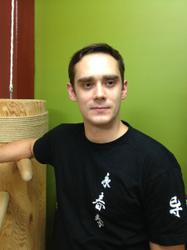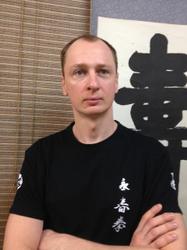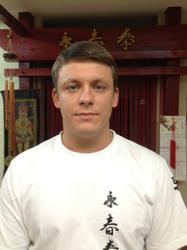Kung Fu, Part 4
Pressure points used in kicks
- IN-TRON – between the eye-brows
- SHOKU – the bridge of the nose
- TYAN-TIN – the carotid artery
- LYANTSUAN – the Adam’s apple, larynx, trachea
- TSUO – the lower part of the chest bone
- UZHONKOAN – the solar plexus
- SONLY – the elbow joint
- UZHANMEN – the anterior (free) end of the 11th rib
- TSZUYKOAN – in the pit of the stomach
- SHEMEN – the hypogastrium
- TSRIURON – the groin area
- KONSUN – the inner side of the foot
- FONFU – the back of the head, the base of the cerebellum
- VALAO – between the 1st and 2nd spinal vertebrae
- SHEN-CHZHU - between the 3rd and 4th spinal vertebrae
- SHEN-DAO - between the 5th and 6th spinal vertebrae
- UZHEIAN - between the 7th and 8th spinal vertebrae
- SHENLYU - between the 2nd and 3rd lumbar vertebrae on both sides of the spine
- SUYANCHU - between the 1st and 2nd lumbar vertebrae
- MINMEN - between the 2nd and 3rd lumbar vertebrae
- LANEOAN - between the 4th and 5th lumbar vertebrae
According to the above list of pain’ pressure points we can conclude that the vast majority of them are located on the back. Using the correct strike’ one may totally paralyse an opponent.
Now let us spend some time on the various commands used at the beginning or just after the end of classes. All of these form part of the classes’ rituals. Anyone studying Kung Fu should know them.
Without ritual, do not act. Without ritual, do not initiate action. Without ritual, do not move from your place.
- DUISIN – meaning form up!’ or stand to attention’
- CHZHANLI – this means stand still’ , stand in line’ (shun)
- HINHAO – means hello’
- HAO – this is a response to a greeting
- CHAN-ZO – this is the meditation before training begins
- TSIN-TSZO – the command to sit down’
- TSILAY – the command to get up’
- KAISHI – meaning begin’
- SEN-SHEN – this is the term for teacher’
- TSZAI-TSZYAN – meaning goodbye’
- LANCI – this is a lesson’, training class’
- LYUVEI – meaning end’
So the commands before the start of a class will sound like this:
“DUISIN, CHZHANLI”, commands the senior student. The teacher then stands in front of the line of students.
He then greets the students: “NINHAO.”
The students reply with “HAO”.
After the greetings one hears the commands: “CHANZO, TSIN TSZO.” At this point the students obey and sit down to begin meditation before the lesson.
After two to three minutes of meditation, the command “TSILAY” sounds and, upon the teacher’s signal, everybody jumps up from their places.
“LANSI KAISHI” commands now sound and the training begins.
Upon completion of training, the senior student commands “DUISIN CHZHANLIM.” At this point, everybody lines up and the teacher commands “TSZAI – TSZYAN, LANSI LUVEI.” The training has now ended.
NAMES OF SPECIAL EXERCISES
TEU-GEN-DI – iron buffalo ploughing the soil
GAN-TSZIN-TSZUAN – diamond fist
FEI-MAI-TSZYAO – a foot flying like a feather
DA-TA-DAI – strikes on sand bags
DAI-TE-VA – wearing iron hoops
DA-MU-ZHEN – striking a wooden dummy
TE-GAN-TUI – a foot like an iron post
SE-TSZY-LOU-LU – scorpion edging along the road
PO-YIN-CHZHOU – an elbow breaking YIN substance
TUI-SHAN CHZHAN – a palm pushing a mountain
PE-CHZHU-GAN – striking a wooden pole
HEI-HU-TYAO-SHAN – a black tiger jumping over a mountain
MAO-CHZHAN – a breaking palm
FEN-CHZHAN – a windy palm
CHEN-CHZHUAN-CHZHAN – a palm breaking a brick
I-CHZHI-TSZIN – a finger as hard as metal
DUKI-KAO-HU - straddling a tiger standing on one foot
POINTS OF ENERGY RELEASE DURING STRIKES AND BREAKING OBJECTS
VAI-GU-AN – located on the back of the fist (a distance of 2 Ts’un above the wrist)
HOU-SI - located on the back of the fist (1 Ts’un above the wrist)
BAI-HUA – the top of the head
SHON-CHZHUN – the middle of the chest
TSZUI-CHUE – a point in line with the heart (6 Ts’un above the navel)
YUN-TSZU-AN – winding spluttering spring, located in the middle of the foot
NAMES OF STRIKES AND BLOCKS
TSUAN - fist
GOU – a hand, a hook
HU-CHZHAN – a hand, a tiger’s paw
LUN-CHZHAN – a hand, a dragon’s paw
IN-CHZHAN – a hand, an eagle’s claw
SHYAKU – a strike made from low down in an upward direction
TIN-CHZHU – a strike made by the elbow
TSA-TSUAN – a hand, a hammer
TSHYANEI-GUN – side strike using the fist
NYDAN – a block made using the inside of the hand
VEKO – a block by the outside of the hand
SAYAN – a downward block by the hand
YU – right side
TSZO – left side
YUTSZO-FEN-ZUN – kicks made by the right or left foot
LU-DA-GUN – a kick made by the back of the foot (donkey’s kick)
SHAN-TSZYAN – an upward block by the hand
LOUTO – sweeping block by the foot
SHISHIKO-DAN – knocking down by the foot in an inward direction
SHITSZYA-SHOU – crossed arms
HU-KOU – a hand, tiger’s jaws
UDAI-TUI – side kick by the foot
DEN-TUI – straight kick by the heel
TUI-CHZHAN – palm strike
CHUN-TSUAN – iron fist punch
STANCES
BIMBU – the frontal stance
MABU – the horse rider stance
GNUNBU – the bow stance
SUIBU – the empty foot stance
PUBU – the low stance like a dragon
DULIMBU – the one foot stance
SEBU – the twisted stance (a monkey in the bushes)
GAIBU – the scissors stance
TSZYAN-CHA – the lengthwise split
HEN-CHA – the cross split
Now let us move on to the secrets of Chinese medicine. I would like to reveal the secrets of Chinese pills, the contents of which I shall divulge later. Chinese national medicine plays a huge role in China. It is mostly based on natural components and the human body channel system (meridians). The secrets of this medicine stem from the ancient roots of Eastern civilisation, as it is known to be the most ancient in the world. In the ancient East, the development of martial arts and medicine always went side by side. It is not possible to imagine one without the other.
SHAOLIN PILLS BRING BACK YOUTH
We take: 120 grams of the herb polygonum multiflorum (boiled in wine), 120g of Chinese wolfberry, 120g of Chinese Dodder seeds, 120g of shiny privet fruits, 60g of Eastern black sesame seeds, 180g of Angelica, 240g of Common Foxglove roots, 120g of black Eclipta, 60g of ginseng, 60g of white flowered peony root, 60g of Celosia cristata seeds, 180g of Japanese Dioscorea (Wild Yam), 60g of Orchid Curculig, 60g of cardamom seeds, 60g of Dendrobium, 60g of goji berries and 30g of zest. Grind all of these into a powder. Then take the highest quality honey. Mould your power and honey into bullet-sized pills and cover them with wax. Dosage: take 1 to 2 pills twice daily washed down with cooled (boiled) water. They can be taken for many years. The pills help to fortify the liver and kidneys, to restore natural hair and face colour. As well as this they improve sight and hearing and strengthen teeth. Pork, butter and fat must not be eaten before taking pills. Nor should you eat raw meats, raw fish and spicy dishes.
SHAOLIN FIVE JEWELS ELIXIR
Take 30g of Japanese Dioscorea, 30g of Songshan Ginseng, 120g of soya beans, 30g of Huan-chi Astragalus root, 120g of fresh Foxglove roots and 12 Chinese dates. Put everything, except the dates, into an earthenware pot and boil for 1 to 2 hours until only one cupful remains. Put the remaining liquid into a cup and add the dates. Apply dates 10 times a month. This is a very good remedy for those engaged in martial arts. It intensifies your energetic power and contributes to speedy body recovery when exercising intensively.
I will finish now with a few short notes about Eastern martial arts.
I would like to remind all those who intend to engage in martial arts: everything in the world is punishable and he who turns his knowledge to evil will be punished by higher powers which are constantly following our every step. The knowledge of martial arts came to us from the universe afar. It is with us to help us stay healthy and to protect us from evil and violence. If this knowledge is transformed into evil, then punishment comes instantly. So think to yourself what you need this knowledge for!



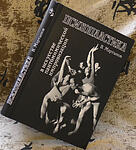

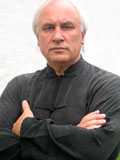 Коан – вопрос к членам Федерации Юн Чун Цюань от президента В.В. Мартынова: «Что Вы сделали для Федерации из того, что не мог бы сделать любой другой за деньги?»
Коан – вопрос к членам Федерации Юн Чун Цюань от президента В.В. Мартынова: «Что Вы сделали для Федерации из того, что не мог бы сделать любой другой за деньги?»
